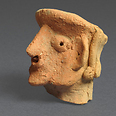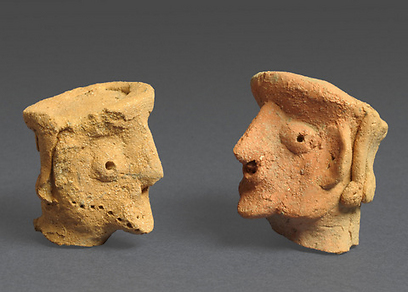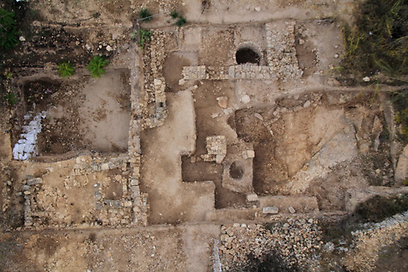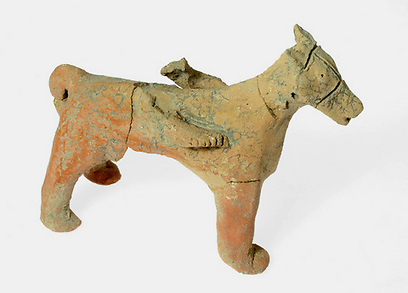
In excavations the Israel Antiquities Authority is currently conducting at the Tel Motza archaeological site, prior to work being carried out on the new Highway 1 from Sha'ar Hagai to Jerusalem by the National Roads Company, a temple and a cache of sacred vessels some 2,750 years old have been uncovered.
According to Anna Eirikh, Dr. Hamoudi Khalaily and Shua Kisilevitz, directors of the excavation on behalf of the Israel Antiquities Authority, "The ritual building at Tel Motza is an unusual and striking find, in light of the fact that there are hardly any remains of ritual buildings of the period in Judaea at the time of the First Temple.
"The uniqueness of the structure is even more remarkable because of the vicinity of the site's proximity to the capital city of Jerusalem, which acted as the Kingdom's main sacred center at the time."
According to the archaeologists, "Among other finds, the site has yielded pottery figurines of men, one of them bearded, whose significance is still unknown."

Figurines of a person (Photo: Clara Amit, courtesy of Israel Antiquities Authority)
Tel Motza and the surrounding region are renowned for their prime archaeological importance. Many finds have previously been uncovered at the site, from a variety of different periods. From the 1990's to the beginning of the present millennium, the site was excavated in preparation for the new route taken by Highway 1.
At the time, the site's archaeologists proposed once more identifying the site with the Biblical settlement "Mozah" mentioned in the Book of Joshua – a town in the tribal lands of Benjamin bordering on Judaea (Joshua 18: 26).
The proposal was based, among other things, on the discovery at the site of a public building, a large structure with storehouses, and a considerable number of silos.

General view of excavation site (Photo: Skyview, courtesy of Israel Antiquities Authority)
At the time, archaeologists identified the site as a storehouse, run by high-ranking officials, for Jerusalem's grain supplies.
The current excavations have revealed evidence that provides another aspect to our understanding of the site.
Extensive research required
According to archaeologists Eirikh, Dr. Khalaily and, Kisilevitz, "The current excavation has revealed part of a large structure, from the early days of the monarchic period (Iron Age IIA).
"The walls of the structure are massive, and it includes a wide, east-facing entrance, conforming to the tradition of temple construction in the ancient Near East: The rays of the sun rising in the east would have illuminated the object placed inside the temple first, symbolizing the divine presence within.
"A square structure, which was probably an altar, was exposed in the temple courtyard, and the cache of sacred vessels was found near the structure.
"The assemblage includes ritual pottery vessels, with fragments of chalices (bowls on a high base which were used in sacred rituals), decorated ritual pedestals, and a number of pottery figurines of two kinds: The first, small heads in human form (anthropomorphic) with a flat headdress and curling hair; the second, figurines of animals (zoomorphic) – mainly of harnessed animals.
"The archeologists stress that "the find of the sacred structure together with the accompanying cache of sacred vessels, and especially the significant coastal influence evident in the anthropomorphic figurines, still require extensive research."

Figurine of a horse (Photo: Clara Amit, courtesy of Israel Antiquities Authority)
Ritual elements in the Kingdom of Judah are recorded in archaeological research, especially from the numerous finds of pottery figurines and other sacred objects found at many sites in Israel, and these are usually attributed to domestic rituals. However, the remains of ritual platforms and temples used for ritual ceremonies have only been found at a few sites of this period.
According to the site's directors, "The finds recently discovered at Tel Motza provide rare archaeological evidence for the existence of temples and ritual enclosures in the Kingdom of Judah in general, and in the Jerusalem region in particular, prior to the religious reforms throughout the kingdom at the end of the monarchic period (at the time of Hezekiah and Isaiah), which abolished all ritual sites, concentrating ritual practices solely at the Temple in Jerusalem."















